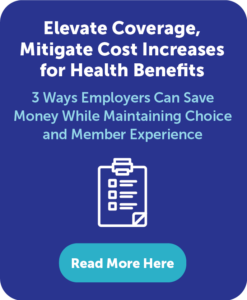by Lucent Health
Share
by Lucent Health
Share

Health plan costs continue to rise for employers providing health coverage for employees. In 2022, the average cost of a family health plan was $22,000, and the average employer foots the bill for 72% of that cost, according to data from Kaiser Family Foundation.
Healthcare doesn’t have to be so expensive. Self-insured employers have options for providing employee health coverage at significantly lower costs than the average plan.
Employers’ 4 Needs for Healthcare Coverage
For you as an employer, cost savings may be your most pressing priority. But offering good care for your employees and their families is equally important if you want to retain valuable employees and maintain productivity and engagement.Most employers need health coverage options that meet the following needs:
- Savings. Uncovering cost savings in health coverage can directly boost your bottom line.
- Choice for members. Employees and their families want access to choices in their own healthcare.
- Positive member experience. Achieving cost savings should not compromise the member experience, as health coverage is the most important benefit for most employees.
- Data. Easily accessible data offers transparency and visibility into your health plan costs and usage.
RBP Dual Option Plans Deliver on All Four Needs
 Lucent Health’s RBP Dual Option health plans can provide levers for employers to access deep cost savings without sacrificing the positive member experience. For almost a decade, Lucent has been administering reference-based pricing (RBP) health plans, which typically save 36% compared with traditional PPO plans. The dual option gives members a choice between a cost-saving RBP plan and a traditional PPO plan.
Lucent Health’s RBP Dual Option health plans can provide levers for employers to access deep cost savings without sacrificing the positive member experience. For almost a decade, Lucent has been administering reference-based pricing (RBP) health plans, which typically save 36% compared with traditional PPO plans. The dual option gives members a choice between a cost-saving RBP plan and a traditional PPO plan.
Savings
RBP plans are custom-built plans, negotiated directly between groups of employers and care providers. While most commercial plans, even those used by large companies, pay hospitals more than 300% of the cost paid by Medicare for any given procedure, RBP plans set rates much lower, such as 140% of Medicare. The RBP option still provides employees access to a Physician and Ancillary PPO network, making it simple to use for common doctor visits, imaging and labs.
Because of the significant savings, employers can offer RBP plans to employees with much lower or zero contributions from the employees. In more than 200 companies that use Lucent’s dual option plan, it’s typical for 70%–75% of employees to choose the RBP option because of the low cost or no cost premiums. As a result, companies that typically spend $12 million per year on health insurance can experience $3.5 million in savings during the first year of offering a dual option plan.
As more employees move to the RBP plan, employers’ costs for the PPO option will also decrease. That can lead to lower premiums or member contributions for the PPO plan as well.
Choice
Employees want choices in their healthcare, and Lucent’s RBP dual option plans are designed with choice in mind. Employees can choose to save on monthly premiums and deductibles by selecting the cost-saving RBP option, but they can also choose a traditional PPO plan.
RBP plans have been proved over more than 10 years and are effectively providing care while reducing costs for members and employers; however, some employees don’t want to try a new type of plan. The dual option allows those members to stick with the familiar PPO plan.
Member Experience
A new approach to healthcare can be bumpy at first, when every provider may not understand the agreed-upon terms. However, RBP has been proven over the past decade, and Lucent has a successful track record of providing RBP plans with an exceptional member experience.
Lucent’s RBP plans are integrated with concierge care management by Narus Health, a Lucent-owned care management company. Narus Health is specifically built to take care of the member and handle any questions regarding the member’s benefit plan or a recent diagnosis. For example, when a member needs to see a specialist, care coordinators can recommend a specialist who is covered under the plan and call ahead to alert the specialist about the plan and the member’s specific needs.
While some people assume a lower-cost RBP plan is just for healthy people, that’s simply not true with concierge care. Many Lucent Health clients see their members with more complicated health needs and disease choosing RBP plans because they can get their special needs met with Narus Health. Lucent Health plan members who choose RBP plans choose the same plan again 95% of the time, indicating they are pleased with the experience.
With dual option, the traditional PPO plan can also include Narus Health’s full suite of services (utilization management, concierge care and case management), so every health plan member can get the right care, at the right time and at the right place.
Data
Lucent Health RBP dual option plans always include access to easy-to-understand data about an employer’s health plan, costs and usage. It’s easy for employers to get visibility on how much they’re spending on healthcare—and how much they’re saving.
Claims and pharmaceutical data is also used to power better plan design and a better member experience. Nightly data feeds to Narus Health allows the care team to identify members that could benefit from Narus Health’s suite of services. The Narus care team will also reach out to members who have a specific diagnosis to see if one of their nurses can help them with any issue.
RBP dual option plans meet the pressing needs of employers and offer choice for employees. In addition to offering the most aggressive, proven cost-saving solution for health coverage with RBP, employers can also offer a traditional plan. With Lucent’s dual option, both types of plans are wrapped with concierge care and other member experience programs that help employers address other cost drivers in health coverage.
The cost of healthcare continues to increase at an unsustainable pace, but growing price transparency is showing that employers could improve […]
When it comes to offering health benefits, employers may often feel as if they have to choose between two opposing goals: […]


